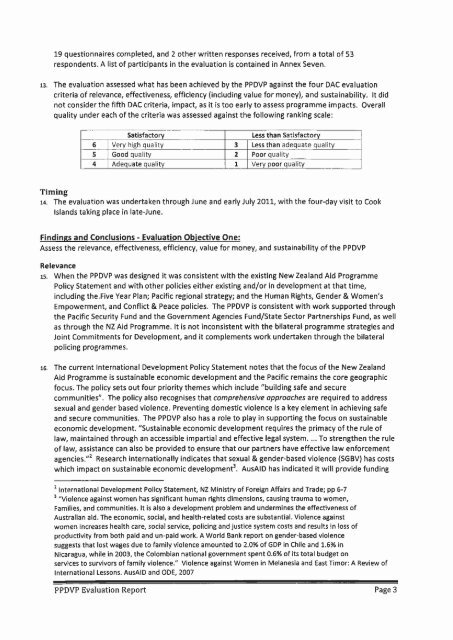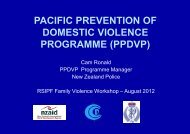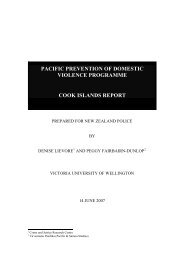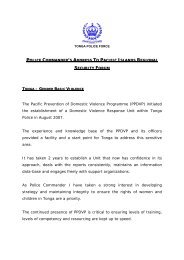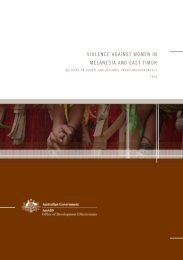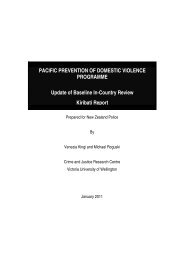PPDVP Evaluation Report - Pacific Prevention of Domestic Violence ...
PPDVP Evaluation Report - Pacific Prevention of Domestic Violence ...
PPDVP Evaluation Report - Pacific Prevention of Domestic Violence ...
You also want an ePaper? Increase the reach of your titles
YUMPU automatically turns print PDFs into web optimized ePapers that Google loves.
19 questionnaires completed, and 2 other written responses received, from a total <strong>of</strong> 53respondents. A list <strong>of</strong> participants in the evaluation is contained in Anne~ Seven.13. The evaluation assessed what has been achieved by the <strong>PPDVP</strong> against the four DAC evaluationcriteria <strong>of</strong> relevance, effectiveness, efficiency (including value for money), and sustainability. It didnot consider the fifth DAC criteria, impact, as it is too early to assess programme impacts. Overallquality under each <strong>of</strong> the criteria was assessed against the following ranking scale:654SatisfactoryVery high qualityGood qualityAdequate quality321Less than SatisfactoryLess than adequate qualityPoor qualityVery poor qualityTiming14. The evaluation was undertaken through June and early July 2011, with the four-day visit to CookIslands taking place in lateJune.Findinps and Conclusions - <strong>Evaluation</strong> Obiective One:Assess the relevance, effectiveness, efficiency, value for money, and sustainability <strong>of</strong> the <strong>PPDVP</strong>Relevance15. When the <strong>PPDVP</strong> was designed it was consistent with the existing New Zealand Aid ProgrammePolicy Statement and with other policies either existing and/or in development at that time,including thelive Year Plan; <strong>Pacific</strong> regional strategy; and the Human Rights, Gender & Women'sEmpowerment, and Conflict & Peace policies. The <strong>PPDVP</strong> is consistent with work supported throughthe <strong>Pacific</strong> Security Fund and the Government Agencies Fund/State Sector Partnerships Fund, as wellas through the NZ Aid Programme. It is not inconsistent with the bilateral programme strategies andJoint Commitments for Development, and it complements work undertaken through the bilateralpolicing programmes.16. The current lnternational Development Policy Statement notes that the focus <strong>of</strong> the New ZealandAid Programme is sustainable economic development and the <strong>Pacific</strong> remains the core geographicfocus. The policy sets out four priority themes which include "building safe and securecommunities". The policy also recognises that comprehensive approaches are required to addresssexual and gender based violence. Preventing domestic violence is a key element in achieving safeand secure communities. The <strong>PPDVP</strong> also has a role to play in supporting the focus on sustainableeconomic development. "Sustainable economic development requires the primacy <strong>of</strong> the rule <strong>of</strong>law, maintained through an accessible impartial and effective legal system. ... To strengthen the rule<strong>of</strong> law, assistance can also be provided to ensure that our partners have effective law enforcementagencies."2 Research internationally indicates that sexual %I gender-based violence (SGBV) has costswhich impact on sustainable economic development3. AusAlD has indicated it will provide fundingInternational Development Policy Statement, NZ Ministry <strong>of</strong> Foreign Affairs and Trade; pp 6-7"<strong>Violence</strong> against women has significant human rights dimensions, causing trauma to women,Families, and communities. It is also a development problem and undermines the effectiveness <strong>of</strong>Australian aid. The economic, social, and health-related costs are substantial. <strong>Violence</strong> againstwomen increazes health care, social service, policing and justice system costs and results in loss <strong>of</strong>productivity from both paid and un-paid work. A World Bank report on gender-based violencesuggests that lost wages due to family violence amounted to 2.0% <strong>of</strong> GDP in Chile and 1.6% inNicaragua, while in 2003, the Colombian national government spent 0.6% <strong>of</strong> its total budget onservices to survivors <strong>of</strong> family violence." <strong>Violence</strong> against Women in Melanesia and East Timor: A Review <strong>of</strong>lnternational Lessons. AusAID and ODE, 2007- --<strong>PPDVP</strong> <strong>Evaluation</strong> <strong>Report</strong> Page 3


